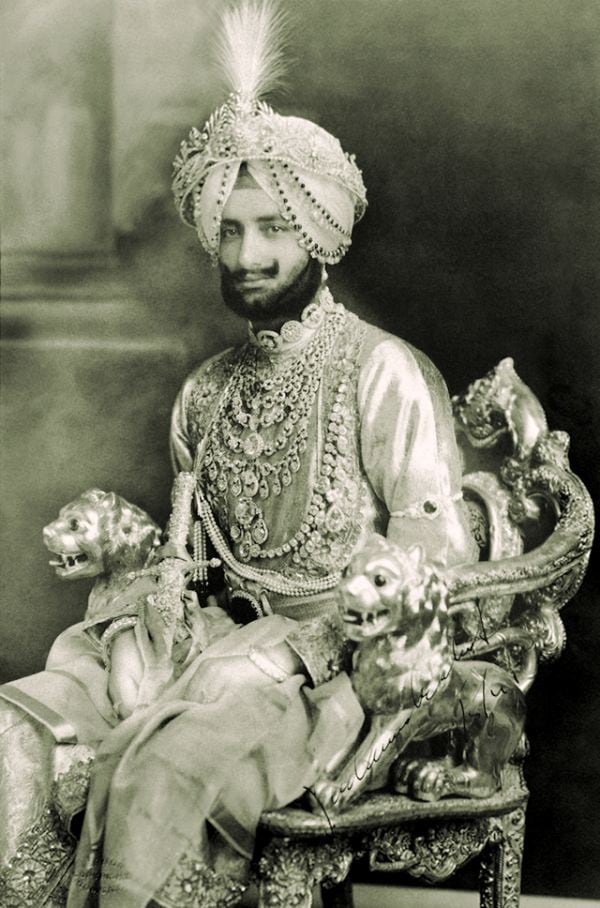Explained: The controversy over a diamond necklace, with roots in India, worn at the Met Gala
The necklace, worn by popular US YouTuber Emma Chamberlain, originally belonged to Maharaja Bhupinder Singh of Patiala.
 Emma Chamberlain attends The Metropolitan Museum of Art's Costume Institute benefit gala on Monday, May 2, 2022, in New York. (Photo by Evan Agostini/Invision/AP)
Emma Chamberlain attends The Metropolitan Museum of Art's Costume Institute benefit gala on Monday, May 2, 2022, in New York. (Photo by Evan Agostini/Invision/AP)Popular US YouTuber Emma Chamberlain is facing widespread criticism for the diamond necklace she wore to this year’s Met Gala. Designed by luxury jewellery maker Cartier, the antique necklace originally belonged to Maharaja Bhupinder Singh of Patiala, and features a De Beers diamond, which was once the seventh largest in the world.
The necklace was said to have disappeared from the Royal Treasury of Patiala around 1948, and parts of it, including the massive Da Beera diamond, were later purchased by Cartier. Within days of the charity event this year, the jewellery designer has been criticised for allowing Chamberlain to wear what has been described as a “part of India’s stolen history”.
But Chamberlain’s fashion choice was not the only controversy at the Met Gala this year. Often called the ‘Oscars of fashion’, the Met Gala is known for ostentatious displays of wealth and extravagance. This year’s dress code, ‘Gilded Glamour’ — a nod to the 19th-century Gilded Age in the United States — was a celebration of just that. But amid a devastating war in Ukraine, soaring inflation, and new waves of the Covid-19 pandemic, many have criticised the charity event for its excessiveness.
What was the theme of the 2022 Met Gala?
The theme of this year’s Met Gala was ‘In America: An Anthology of Fashion’, which was meant to act as a second instalment to last year’s theme, ‘In America: A Lexicon of Fashion’. According to Vogue, the second installation by Andrew Bolton — the Wendy Yu Curator in Charge of the Costume Institute — “centres on the tenets of American style and prizes the anonymous and unsung heroes of US design”.
The dress code, ‘Gilded Glamour’, referred to the two decade period between 1870 and 1890, where there was “unprecedented prosperity, cultural change, and industrialisation”. Guests were expected to look to ‘Gilded Age New York’ for inspiration.
 Maharaja Yadavindra Singh wearing the Patiala necklace in the 1930s (Source: Wikimedia Commons)
Maharaja Yadavindra Singh wearing the Patiala necklace in the 1930s (Source: Wikimedia Commons)
Why was Chamberlain’s necklace controversial?
Chamberlain walked the Met Gala red carpet as the brand ambassador for Cartier. Dressed head to toe in Louis Vuitton, her outfit was paired with a vintage platinum and diamond Cartier tiara dating back to 1911, and the necklace in question. In an interview with Vogue, she said: “During the Gilded Age, it was all about being extravagant and I’ve never seen a more extravagant necklace.”
In the days since the event, Chamberlain and Cartier have faced considerable backlash over the necklace. The South Asian community, particularly Indian Americans, said it was in poor taste for the jewellery brand to allow an ‘influencer’ to “flaunt stolen goods” on the Met Gala red carpet.
What is the story of the De Beers diamond in her necklace?
The choker was originally part of a collection of five chains and a neck collar, collectively known as the Patiala necklace. It was created for the Maharaja of Patiala Bhupinder Singh in 1928 and comprised around 2,900 diamonds, including the De Beers — which at the time, was the world’s seventh-largest diamond.
In 1948, the necklace allegedly went missing from the royal Treasury of Patiala following the British rule in India. In 982, at a Sotheby’s auction in Geneva, the “De Beers” diamond reappeared and was sold. After managing to recover a part of the necklace at a second-hand jewellery store in London in 1998, Cartier has tried to restore it by replacing the missing diamonds and stones with replicas, Mashable reported.
Newsletter | Click to get the day’s best explainers in your inbox
Why is it being compared with Kim Kardashian’s controversial choice of wearing Marilyn Monroe’s dress?
Suggesting a racial bias, some pointed out that Chamberlain wearing the necklace did not garner the same widespread attention and backlash as reality star Kim Kardashian got when she chose to wear Marilyn Monroe’s dress on the red carpet.
Kardashian wore the golden gown Monroe famously wore while singing “Happy Birthday Mr President” to President John F Kennedy in 1962. Embellished with 2,500 (some accounts say 6,000) hand-sewn crystals, it is the world’s most expensive dress.
According to New York Post, Kardashian was able to persuade Ripley’s Believe It or Not! to loan her the dress, and it came with “armed guards and gloves”. She later changed into a replica of the dress for the actual event.
But her decision to wear the dress drew criticism from audiences, who said that it’s a part of American history and should be treated with utmost care.
Photos





- 01
- 02
- 03
- 04
- 05

































